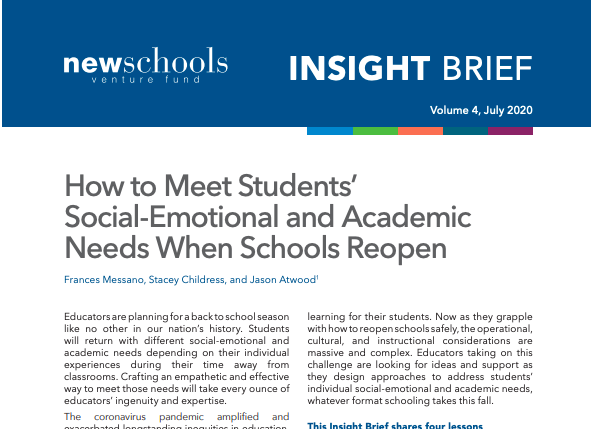By Tiffany Cheng Nyaggah, Partner, NewSchools Venture Fund

Equity-minded entrepreneurs gravitate to the exciting work of creating something new because they are deeply committed to building a more just and compassionate world. Earlier this year, few leaders would have imagined a threat to their organization arriving in the form of a pandemic, which would upend revenue forecasts, operations, and prospects for long-term survival. And yet, the effects of COVID-19 and the murders of George Floyd, Breonna Taylor, Ahmaud Arbery, and many others, have highlighted the criticality of work that addresses and dismantles systemic and structural racism against people of color, particularly Black individuals.
Given this, nonprofit leaders must find ways to safeguard and courageously advance their mission. Even as leaders set out to listen and care for communities in pain, they must also navigate the impact of economic and societal uncertainties to withstand and overcome extraordinary challenges facing the nonprofit sector. Our friends at the Bridgespan Group and The Management Center recently shared several principles, strategies, and tools with leaders we fund through our Diverse Leaders investment area. Here are four major takeaways:
- Scenario planning starts with values.
Understanding who we are as leaders and organizations is imperative for staying anchored in the flurry of program implementation and technical decisions, especially when there are many unknowns and constraints. More than ever, we need leaders to step back from their work long enough to evaluate and live their values. A vital place to start is to ask, “how does equity impact our organization’s financial budgets, especially as it relates to staff capacity, wages, and benefits?” What you choose to cut, how you think about cutting it, and how you communicate these cuts will matter. Your community will remember. If one of your core values is to serve your community well, consider how to equitably share that burden among your staff, board members, and advisors. Leaders will face choices about balancing the workload and stress with new and continuing demands on staff. During this extended crisis, our collective humanity needs affirming. Leaders who model self-care permit others to do the same. Diverse teams may need to hear that attending to one’s mental health and emotional well-being is as important as meeting objectives for long-term organizational sustainability. Certainly, honoring values can be difficult, but embracing these tensions will lead to better choices. - Balance near-term action AND long-term planning.
Before the pandemic, before George Floyd’s murder, the need for equity-focused work was immense across every sector. While COVID-19’s enormous economic impact may rival the Great Depression, sustained protests calling for racial justice over the past month have forced many companies to look inward at their systemic racism. While it remains to be seen whether this work will go beyond surface-level decrees and hit-and-run performative DEI workshops, equity-minded entrepreneurs must manage new inbound requests, an unknown revenue landscape, and long-term viability. Many organizations will need to manage cash and adjust operations in the near-term so that there is a runway to learn, adapt, and grow. Simultaneously, leaders must build plans to adjust the organization for a range of possible scenarios and beneficiary needs. - Scenario planning must be dynamic and iterative amidst changing circumstances.
Start by identifying key drivers, risks, and opportunities. It may be helpful to start with the assumptions that will have the most significant impact on your ability to survive and thrive as an organization. Leaders can model three future possibilities using the best-, worst-, and middle-case scenarios by imagining the likely impact on revenue, programs, and teams. For example, what actions and decisions get triggered if schools are in a distance-learning mode in the fall? What if unexpected revenue comes through from a funder providing COVID-19-related investment? Now may also be an opportune moment to consider new and creative ways to achieve organizational objectives given known constraints. Revisiting your assumptions is a great way to ensure your plans remain relevant, and you’re taking appropriate measures. - Seek perspective from trusted collaborators, rising leaders on staff, and members of the community.
At times, entrepreneurs of color may self-isolate for survival when faced with daunting challenges. Moreover, the imposter syndrome can also keep leaders of color from asking for help due to fear of appearing unqualified. There is another, better way: entrepreneurs can gather all of the unknowns and rally their collective to discuss and develop solutions. Look beyond seniority and engage staff on the frontlines, whose experiences and perspective are valuable assets when considering changes to programs. Use a structured process to invite and consider diverse perspectives. In the end, trust your instincts and make decisions with a clear mind and voice.
In times of crisis, leaders can allay staff and community anxiety by (re)casting an ambitious vision. Doing so requires us to remember that entrepreneurship is the thrilling pursuit to create new possibilities with our communities. By applying these principles, we can ensure that equity work thrives and helps us emerge as a stronger and more just society.
If you’re a school leader or a school system leader, check out our #DistanceLearningLessons webinar series for lessons and resources that can inform the decisions you’re making now to reopen schools safely in the fall.



